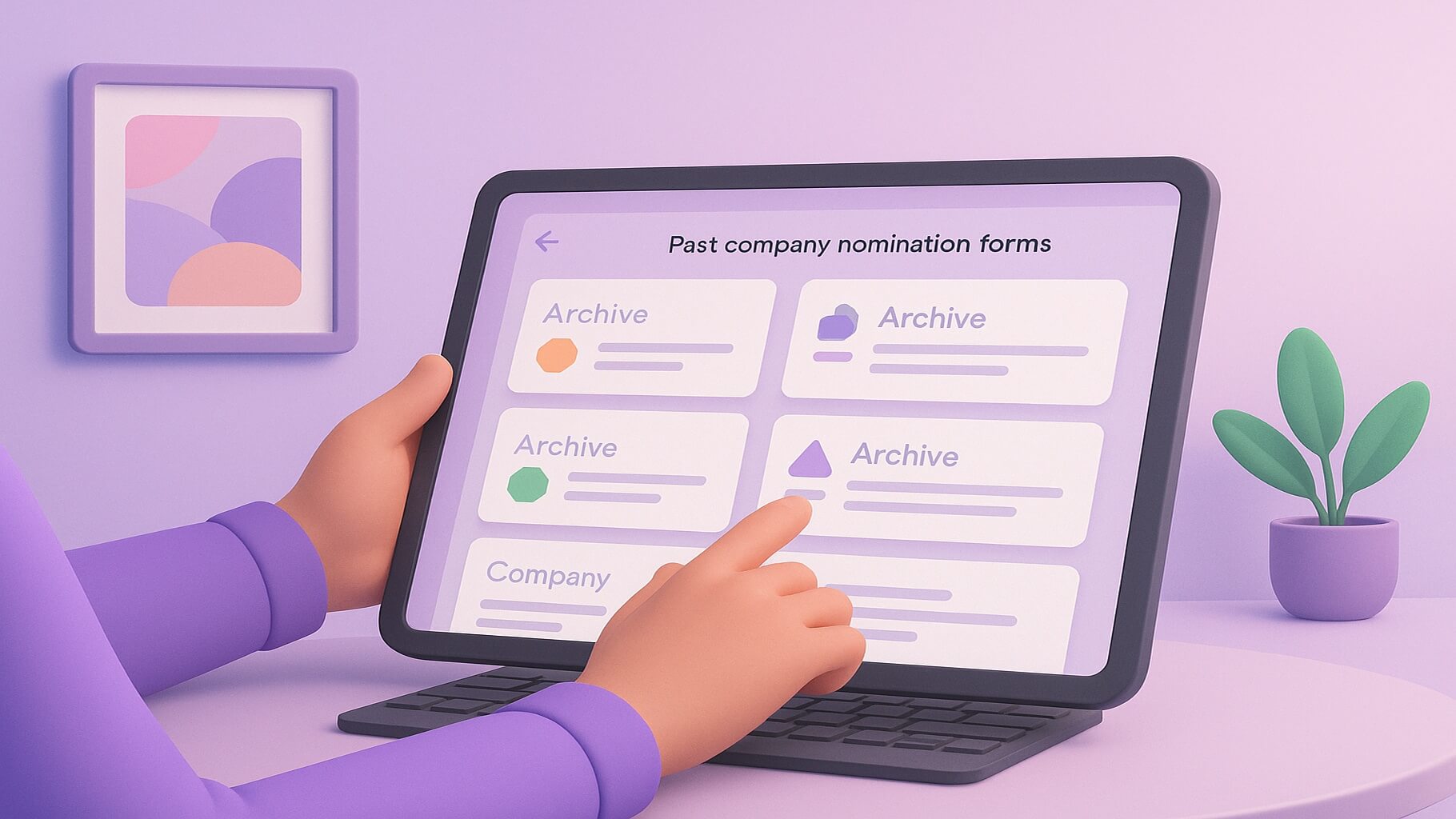
Designing an effective company nomination form can feel overwhelming when you're trying to balance comprehensive data collection with a user-friendly design that people will actually complete. Many organizations struggle with nomination form templates that either capture too little information for fair evaluation or become so lengthy that busy employees abandon them halfway through the submission process.
Whether you're developing an employee nomination form for corporate environments, sports clubs, or educational institutions, the challenge remains consistent: designing forms that gather meaningful achievement details while maintaining simplicity. At Matter, we see organizations wrestling with these exact challenges every day. These organizations want to recognize exceptional employees effectively. However, they struggle with forms that either don't capture enough detail or create barriers to participation.
This guide provides 37 practical nomination form templates and examples that address these common pain points, helping you create submission processes that actually work for your team while supporting meaningful recognition outcomes.
What are company nomination forms?

Company nomination forms represent structured digital or paper-based tools that organizations use to collect nominations for various award categories and recognition programs. These forms enable the systematic collection of nominee information, achievement details, and supporting evidence that evaluation committees need to make informed decisions. Effective nomination forms streamline the nomination process while ensuring that all necessary information is captured consistently across different submission types and award nominations, incorporating best practices found in successful staff nomination examples that demonstrate effective data collection strategies.
Understanding nomination forms in employee recognition programs
Employee recognition programs rely on well-designed nomination forms to gather comprehensive information about potential award recipients across various organizational levels. These forms serve as the primary data collection mechanism for recognition programs, capturing details about achievements, contributions, and the impact that nominees have made within their teams or departments.
Essential components of nomination forms include:
- Structured form fields that capture specific nominee information and achievement details
- Clear award categories that help nominators select the appropriate recognition type
- Template sections for documenting measurable contributions and supporting evidence
- Submission guidelines that ensure nominators understand the nomination process requirements
Modern nomination forms have evolved beyond simple paper-based submissions to include sophisticated online nomination form templates that integrate with existing HR systems, providing automated workflow capabilities. These digital solutions enable organizations to create more efficient processes while maintaining the comprehensive data collection that evaluation committees require.
How nomination forms differ from general feedback collection
While general feedback forms focus on ongoing performance conversations and improvement opportunities, nomination forms serve a distinct purpose in organizational recognition strategies. These specialized forms target exceptional achievements that warrant formal recognition, requiring nominators to provide detailed evidence of outstanding contributions and their measurable impact on organizational success. Organizations can improve their nomination effectiveness by studying proven employee recognition nomination examples that demonstrate how to structure forms for maximum impact.
Key differences include:
- Specific achievement documentation rather than general performance observations and routine feedback
- Formal submission requirements, including detailed descriptions and supporting evidence for evaluation
- Structured evaluation criteria that enable consistent assessment across all submitted award nominations
- Recognition outcomes, such as awards, public acknowledgment, or employee rewards, are tied directly to nomination submissions.
The nomination form template serves as a crucial bridge between identifying exceptional performance and delivering meaningful recognition. This process supports employee engagement initiatives. It also contributes to the development of organizational culture across the company.
Types of nomination forms used across different organizations
Organizations implement various types of nomination forms depending on their culture, size, and recognition objectives. Each form type serves different purposes and engages different stakeholder groups in the recognition ecosystem, from corporate environments to school systems and sports clubs.
Common nomination form variations include:
- Employee nomination forms where colleagues nominate teammates for exceptional collaboration or performance
- Award nomination form templates designed for specific recognition categories and achievement types
- Cross-departmental nomination processes that recognize collaboration and organization-wide impact
- Self-nomination opportunities allow individuals to highlight their own significant contributions and achievements
Organizations ranging from businesses to sports clubs and educational institutions adapt these basic form structures to meet their specific recognition needs while maintaining consistency in data collection and evaluation processes.
Why are company nomination forms important

Structured nomination forms serve as the backbone of effective employee recognition programs, creating systematic approaches to identifying and celebrating exceptional contributions across all organizational levels. These forms ensure that recognition efforts remain consistent, fair, and aligned with the company's values, while providing clear pathways for acknowledging diverse types of achievements. Well-designed nomination forms generate valuable data about employee performance patterns, helping organizations understand which behaviors and contributions drive success. This understanding supports comprehensive employee nomination strategies that systematically recognize excellence.
Benefits of structured nomination processes for fair recognition
Formal nomination forms eliminate bias and favoritism by establishing clear criteria and transparent evaluation methods for recognizing outstanding performance. These systematic methods guarantee that everyone has the same chance to be recognized, no matter how visible they are to leadership or what department they work in. By documenting achievements through detailed nomination forms, organizations create comprehensive records of excellence that support career development decisions.
Key advantages of structured nomination processes include:
- Consistent evaluation standards that apply the same criteria across all nomination submissions and departments
- Documented evidence of achievements that support objective decision-making processes and award selections
- Inclusive recognition opportunities that capture contributions from all organizational levels and team members
- Performance tracking capabilities that identify trends and patterns in employee excellence and engagement
The systematic approach to collecting nominations through standardized forms enables organizations to identify emerging talent while ensuring that exceptional contributions receive appropriate recognition, regardless of the nominee's role or department.
Impact of nomination forms on employee engagement and culture
Regular nomination processes significantly boost employee engagement by creating cultures where exceptional work receives consistent acknowledgment and celebration. When organizations actively seek out and recognize outstanding contributions through structured nomination forms, employees feel more valued and motivated to maintain high performance standards. This systematic approach to recognition strengthens workplace relationships and encourages collaborative behaviors that support the comprehensive objectives of an employee recognition program.
Cultural benefits of nomination form processes include:
- Increased motivation as employees see their efforts recognized through formal nomination submissions
- Stronger peer relationships through collaborative nomination activities and team recognition initiatives
- Enhanced retention rates resulting from improved job satisfaction and feeling valued by the organization
- Positive workplace atmosphere that encourages excellence and mutual support among all team members
Studies from several groups demonstrate that employees who get regular praise through official nomination systems are much more likely to stay with their company. These same employees also tend to recommend their workplace as a positive environment to others.
How nomination forms improve program effectiveness and tracking
Digital nomination form templates streamline the entire recognition process by standardizing information collection, automating workflows, and providing administrators with comprehensive data about recognition patterns. These forms eliminate manual administrative tasks while ensuring that all necessary information is captured consistently across submissions. Advanced form features enable organizations to track participation rates, identify recognition gaps, and measure the impact of their programs.
Effectiveness improvements through nomination forms include:
- Automated data collection that reduces administrative burden and processing time for evaluation committees
- Standardized information formats that enable easier comparison and evaluation of submitted award nominations
- Real-time analytics that provide insights into recognition trends and program effectiveness across departments
- Integration capabilities that connect nomination data with broader HR and performance management systems
These technological enhancements help organizations create more efficient recognition programs while maintaining the comprehensive evaluation standards that ensure fair and meaningful award selections.
12 company nomination form examples by category

Effective nomination forms must be tailored to specific recognition categories and organizational needs, capturing relevant information while maintaining a user-friendly submission process. Different award categories require unique form fields and evaluation criteria that align with the specific achievements being recognized. These examples demonstrate how organizations can create targeted nomination form templates that gather necessary information for fair and comprehensive evaluation processes, drawing inspiration from successful team nomination examples that showcase category-specific approaches.
4 employee of the month nomination form examples
Employee of the month nomination forms focus on recognizing consistent excellence and positive impact within defined time periods. These forms typically emphasize recent achievements, behavioral observations, and specific contributions that exemplify organizational values or exceptional performance standards.
Example 1: Performance excellence focus
This template emphasizes quantifiable achievements and measurable impact on team or organizational goals. The form includes sections for specific accomplishments, metrics or results achieved, and descriptions of how the nominee exceeded standard expectations during the nomination period. Form fields capture detailed performance data that evaluation committees can use to assess the significance of contributions.
Example 2: Values-based recognition
This approach centers on behaviors that demonstrate core organizational values through daily actions and interactions. The nomination form asks nominators to describe specific instances where the nominee exhibited values-driven behavior and explain the positive impact on colleagues or customers. This template works particularly well for organizations seeking to reinforce cultural alignment.
Example 3: Team collaboration emphasis
This template highlights contributions to team success, collaborative efforts, and support provided to colleagues. Form fields focus on teamwork examples, mentoring activities, and ways the nominee enhanced overall team performance or morale. The form structure encourages detailed descriptions of interpersonal contributions that might otherwise go unrecognized.
Example 4: Innovation and problem-solving
This nomination form targets creative solutions, process improvements, and innovative approaches to challenges. Nominators describe specific problems the nominee addressed, creative solutions implemented, and measurable outcomes or improvements resulting from their efforts. The template includes sections for documenting both the innovation process and its organizational impact.
4 performance excellence nomination form templates
Performance excellence nomination forms require detailed documentation of achievements that significantly exceed standard expectations or deliver exceptional business results. These forms capture specific metrics, project outcomes, and quantifiable contributions that demonstrate superior performance levels. Organizations developing these comprehensive forms often reference successful employee award nomination example materials to understand how to effectively document exceptional achievements and measurable outcomes.
Example 1: Project achievement template
This comprehensive form template documents the nominee's major project successes, leadership roles, and measurable outcomes delivered. Sections include project scope, challenges overcome, results achieved, and impact on organizational objectives. The form structure guides nominators through a systematic documentation process that evaluation committees can easily assess.
Example 2: Customer service excellence
This template focuses on enhancing exceptional customer interactions, improving customer satisfaction, and improving service quality. Form fields capture customer feedback, service metrics, and specific examples of going above and beyond standard service expectations. The nomination form includes space for supporting evidence such as customer testimonials or satisfaction scores.
Example 3: Sales performance recognition
This form documents outstanding sales achievements, relationship-building success, and revenue impact generated by the nominee. Key sections include sales metrics, client relationship examples, and descriptions of strategies that led to exceptional results. The template accommodates various sales environments from corporate settings to retail organizations.
Example 4: Leadership development template
This comprehensive template recognizes emerging leadership qualities, mentoring contributions, and positive influence on team development. The form captures leadership examples, team impact stories, and descriptions of how the nominee supports the professional growth of others. This template is effective in identifying future organizational leaders.
4 peer recognition nomination forms for employee recognition examples
Peer nomination forms enable colleagues to recognize one another's contributions, support, and collaborative behaviors that may not be visible to management. These templates focus on interpersonal relationships, mutual support, and the positive impact employees have on their immediate work environment.
Example 1: Supportive colleague recognition
This template captures instances of exceptional support, assistance during challenging periods, and ways the nominee helps colleagues succeed. Form fields focus on specific support examples, impact on work quality, and descriptions of helpful behaviors that create positive team dynamics.
Example 2: Knowledge sharing template
This form recognizes employees who actively share expertise, mentor others, and contribute to organizational learning. Sections include teaching examples, knowledge transfer activities, and descriptions of how the nominee shares benefits with team capabilities. The template encourages documentation of both formal and informal knowledge sharing.
Example 3: Positive attitude recognition
This template recognizes employees who maintain positive attitudes, boost team morale, and foster a welcoming work environment. The form fields capture examples of positivity, their impact on the team atmosphere, and specific behaviors that enhance the workplace culture across different organizational settings.
Example 4: Cross-department collaboration
This comprehensive form recognizes employees who excel at working across departmental boundaries, facilitating communication, and building bridges between different organizational areas. Key sections document collaboration examples, communication facilitation, and positive outcomes from cross-functional efforts that benefit the entire organization.
10 nomination form templates by format

Different organizations require varying levels of complexity and structure in their nomination processes, leading to diverse template formats that accommodate different submission preferences and evaluation needs. The choice of template format significantly impacts both nominator participation rates and the quality of information collected during the nomination process. These templates demonstrate how organizations can strike a balance between comprehensive information gathering and user-friendly submission experiences.
4 structured nomination form templates with scoring criteria
Structured templates with built-in scoring mechanisms enable consistent evaluation across multiple nominations while providing clear guidance to nominators about the information needed for successful submissions. These forms typically include weighted criteria, rating scales, and detailed evaluation rubrics that support objective decision-making processes. Organizations can enhance their evaluation consistency by incorporating proven strategies from effective employee recognition nomination form designs that emphasize fair and systematic assessment methods.
Example 1: Weighted criteria template
This comprehensive template assigns specific point values to various achievement categories, allowing for a quantitative comparison across nominations. Sections include performance metrics, collaboration examples, innovation contributions, and values demonstration with predetermined scoring weights. The form structure guides nominators through each evaluation criterion while providing clear scoring guidelines.
Example 2: Behavioral competency scoring
This structured form evaluates nominees against predefined behavioral competencies using standardized rating scales. Each competency section includes specific examples and evidence requirements, with scores ranging from meets expectations to significantly exceeds expectations. The template works effectively across various organizational contexts, including businesses, sports clubs, and educational institutions.
Example 3: Impact assessment framework
This template measures the organizational impact of nominee contributions using structured categories, including team impact, customer impact, operational impact, and strategic impact. Each category includes specific questions and supporting evidence requirements that help evaluation committees understand the scope and significance of achievements.
Example 4: Multi-dimensional evaluation
This comprehensive form evaluates nominees across multiple dimensions, including technical skills, leadership potential, cultural fit, and business results. Each dimension includes detailed criteria and specific evidence requirements to ensure a thorough assessment. The template accommodates complex evaluation needs while maintaining a clear structure for nominators.
3 simplified nomination form examples for quick submissions
Simplified templates reduce barriers to participation by focusing on essential information while maintaining the quality needed for effective evaluation processes. These streamlined approaches encourage broader participation from busy employees who might otherwise skip more complex submission processes.
Example 1: Three-question format
This minimalist template includes only essential questions about achievements, impact, and recognition worthiness. Each question includes guidance for effective responses while keeping the submission process manageable. The form works well for organizations seeking to maximize participation rates while capturing core information.
Example 2: Achievement highlight template
This streamlined form focuses on a single, significant achievement, accompanied by supporting details. Sections include achievement description, impact explanation, and specific outcomes that demonstrate exceptional performance. The template encourages focused submissions that highlight the most compelling evidence for recognition.
Example 3: Quick recognition format
This efficient template captures key information through structured prompts and dropdown menus, reducing typing requirements while ensuring consistent data collection. The form includes predefined categories and standardized response options that accelerate completion while maintaining evaluation quality.
3 digital nomination forms for employee recognition templates
Digital templates leverage technology features to enhance user experience, automate data collection, and integrate with existing organizational systems. These advanced forms include interactive elements, automated notifications, and analytics capabilities that streamline the entire nomination process from submission to award distribution.
Example 1: Interactive multimedia template
This advanced digital form allows nominators to include photos, videos, and documents as supporting evidence for their submissions. Interactive form fields adapt based on previous responses, presenting relevant follow-up questions that gather additional context to inform future decisions. The template includes security features that protect sensitive nominee information throughout the submission process.
Example 2: Mobile-optimized template
This responsive design template ensures optimal user experience across desktop and mobile devices, enabling nominations from any location. The form includes touch-friendly interfaces, voice-to-text capabilities, and offline submission options for convenience. This approach significantly increases participation by accommodating various user preferences and work environments.
Example 3: Automated workflow template
This sophisticated digital form includes automated routing, approval workflows, and notification systems that streamline the entire process from submission to final decision. Integration features connect with existing HR systems and communication platforms for seamless operation. The template includes comprehensive analytics that track submission patterns and program effectiveness.
8 employee of the month nomination examples with forms

Employee of the month nomination programs require specialized forms that capture recent achievements, consistent performance, and specific contributions within defined time periods. These targeted templates help organizations identify employees who demonstrate exceptional dedication, achieve outstanding results, or significantly impact their teams during the nomination period. Effective employee of the month forms strike a balance between comprehensive evaluation and efficient submission processes that encourage broad participation, often incorporating best practices found in proven employee of the month nomination form designs.
3 monthly recognition nomination form examples
Monthly recognition programs require forms that focus on recent achievements and their immediate impact, rather than long-term performance patterns. These templates emphasize current contributions, recent accomplishments, and specific examples from the past month that demonstrate exceptional performance or value alignment.
Example 1: Recent achievement focus
This template specifically targets accomplishments from the current month, requiring nominators to provide detailed descriptions of recent projects, contributions, or behaviors that exemplify excellence. Form sections include achievement timeline, specific outcomes, and immediate impact on team or organizational goals. The template includes form fields that capture both quantitative results and qualitative observations.
Example 2: Monthly impact assessment
This comprehensive form evaluates the nominee's overall impact during the nomination period, including contributions to team productivity, customer satisfaction, or process improvements. Key sections document measurable results, peer feedback, and specific examples of exceptional performance that occurred within the designated timeframe.
Example 3: Values-in-action template
This values-focused form highlights instances where the nominee demonstrated core organizational values through their actions and decisions during the month. Nominators describe specific behavioral examples, value alignment, and positive influence on workplace culture or team dynamics. The template works effectively across various settings, including corporate environments, sports clubs, and educational institutions.
3 peer-submitted employee of the month nomination form templates
Peer-driven nomination processes empower colleagues to recognize each other's contributions while providing valuable insights into team dynamics and collaborative relationships. These templates focus on interpersonal impact, mutual support, and the positive influence employees have on their immediate work environment.
Example 1: Collaborative excellence template
This peer-focused form captures examples of exceptional teamwork, support provided to colleagues, and contributions to positive team dynamics. Sections include collaboration examples, support instances, and descriptions of how the nominee enhances team effectiveness. The template encourages detailed documentation of peer relationships and mutual support behaviors.
Example 2: Peer support recognition
This template specifically recognizes employees who go above and beyond to help colleagues succeed, share knowledge, or provide assistance during challenging periods. Form fields focus on specific support examples, knowledge-sharing instances, and the positive impact on peer success. The nomination form includes sections for describing both formal and informal assistance provided.
Example 3: Team culture builder
This comprehensive form acknowledges employees who actively contribute to positive workplace culture, boost team morale, and create inclusive environments where everyone feels valued. Key sections document culture-building activities, examples of positive influence, and contributions to team cohesion that benefit the entire organization.
2 manager-recommended employee nomination form examples
Manager-initiated nominations provide leadership perspective on employee achievements, performance excellence, and contributions that align with organizational objectives. These templates enable supervisors to formally recognize direct reports while documenting specific achievements and performance indicators that support career development opportunities.
Example 1: Performance excellence documentation
This comprehensive manager template documents exceptional performance metrics, goal achievement, and contributions that exceed standard expectations. Sections include quantifiable results, performance comparisons, and specific examples of leadership potential or skill development demonstrated by the nominee. The form structure supports detailed performance analysis while maintaining focus on recognition objectives.
Example 2: Strategic contribution recognition
This advanced template focuses on employee contributions to strategic initiatives, organizational objectives, and long-term business success. Form sections capture strategic project involvement, innovation contributions, and alignment with organizational priorities. The template includes space for documenting both individual achievements and collaborative efforts that support broader organizational goals.
10 nomination form best practices for employee recognition

Creating effective nomination forms requires careful attention to user experience, efficient information collection, and integration with broader recognition program objectives. Best practices ensure that forms capture necessary information while maintaining high participation rates and supporting fair evaluation processes. These guidelines help organizations develop nomination systems that engage participants, streamline administration, and deliver meaningful recognition outcomes.
4 form design principles for effective nomination forms
Thoughtful form design significantly impacts both submission quality and participation rates, making it essential to balance comprehensive information gathering with user-friendly interfaces. Effective design principles focus on intuitive navigation, clear instructions, and logical information flow that guides nominators through the submission process. These principles are especially important when developing employee of the month nomination template materials that need to encourage broad participation while maintaining evaluation quality.
Key design principles include:
- Clear structure and navigation with logical section organization and progress indicators that guide users
- Contextual help and guidance, providing specific instructions and examples for each form section
- Mobile-responsive design ensuring forms work effectively across all devices and screen sizes.
- Visual appeal and engagement, creating attractive interfaces that reflect organizational branding and encourage completion.
Clear structure and navigation organize form sections logically with clear headings, progress indicators, and intuitive field arrangements that guide users through the submission process. Visual hierarchy highlights important sections and provides clear navigation options that allow users to review and edit their responses before final submission.
Contextual help and guidance provide specific instructions, examples, and help text for each form section to ensure nominators understand what information is needed and how to provide effective responses. This includes sample responses, character limits, and formatting guidance that help users submit high-quality nominations that meet evaluation criteria.
3 user experience best practices for nomination forms
Optimizing user experience reduces abandonment rates and improves submission quality by removing barriers and frustrations that might prevent completion. These practices focus on efficiency, clarity, and user satisfaction throughout the nomination process.
Essential user experience practices include:
- Progressive disclosure and smart defaults that present information and form fields progressively based on user selections
- Error prevention and validation, implementing real-time validation that catches errors immediately, with helpful correction guidance
- Save and resume functionality enables users to save partial submissions and return later to complete the process.
Progressive disclosure and smart defaults present information and form fields progressively, showing only relevant sections based on previous responses. Smart defaults, pre-populated fields where appropriate, and conditional logic adapt the form based on user selections to reduce completion time and cognitive load for nominators.
Error prevention and validation implement real-time validation that catches errors immediately and provides helpful correction guidance. Design forms to prevent common mistakes through input formatting, required field indicators, and clear error messages that help users correct issues quickly without losing their progress. These validation principles are particularly important in peer nomination processes where user-friendly design encourages broader participation.
3 automation features for nomination forms
Automation capabilities reduce administrative burden while improving process efficiency and user experience. These features streamline workflows, ensure consistent follow-up, and provide valuable data insights that support program optimization and improvement.
Critical automation features include:
- Automated routing and approval workflows that intelligently send nominations to appropriate reviewers based on categories
- Notification and reminder systems that deploy automated communications for confirmations, status updates, and deadline reminders
- Analytics and reporting integration that connects nomination forms with analytics platforms for comprehensive program tracking
Automated routing and approval workflows implement intelligent routing that automatically sends nominations to appropriate reviewers based on award categories, departments, or organizational hierarchy. Automated approval workflows manage the review process efficiently while maintaining appropriate oversight and decision-making authority throughout the evaluation process.
Notification and reminder systems deploy automated notification systems that confirm receipt of nominations, provide status updates to nominators, and send reminders about upcoming deadlines or required actions. These systems keep all stakeholders informed and engaged throughout the process while reducing administrative workload.
How to create effective nomination forms

Building successful nomination forms requires strategic planning that balances comprehensive information collection with user-friendly submission experiences. The development process must consider both nominator needs and administrative requirements while ensuring that forms support fair evaluation and meaningful recognition outcomes. Effective forms serve as the foundation for successful recognition programs by capturing the right information in formats that enable efficient processing.
Essential elements every nomination form should include
Comprehensive nomination forms must capture specific categories of information that enable fair evaluation while providing nominators with clear guidance about what details to include. These essential elements ensure consistency across submissions and support objective assessment processes that recognize genuine achievements and contributions. Organizations often benefit from reviewing employee nomination sample materials to understand effective information collection strategies.
Core information categories include:
- Nominee identification details, including name, department, role, and contact information for verification purposes
- Achievement descriptions with specific examples, timeframes, and measurable outcomes or organizational impact
- Supporting evidence sections for documentation, metrics, or additional context that validate claims and achievements
- Nominator information, including relationship to nominee and contact details for follow-up questions if needed
Additional essential elements support program administration and evaluation consistency. Forms should include clear submission guidelines, evaluation criteria explanations, and privacy statements that protect both nominee and nominator information throughout the process. Security features keep sensitive data safe while letting assessment committees have the access they need.
The nomination form template should accommodate various award categories while maintaining consistent data collection standards. Whether organizations serve businesses, sports clubs, educational institutions, or other groups, the basic information requirements remain similar while allowing for category-specific customization.
Design techniques for user-friendly nomination forms
User-centered design principles significantly impact participation rates and submission quality by reducing barriers and creating positive experiences for nominators. Effective design techniques prioritize intuitive interfaces, clear communication, and efficient workflows that facilitate completion while gathering high-quality information. These principles apply broadly to various employee recognition and rewards programs that utilize user-friendly submission processes.
Key design strategies include:
- Logical section progression that follows natural thought patterns and storytelling approaches for information flow
- Visual hierarchy using headings, spacing, and formatting to guide attention and improve comprehension.
- Input variety combining text fields, dropdown menus, rating scales, and file upload options for different data types
- Progress indicators showing completion status and remaining sections to maintain nominator motivation throughout the process.
Advanced design techniques leverage technology to enhance user experience through innovative features. These features include auto-save functionality, smart field validation, and responsive layouts. The responsive design ensures optimal performance across different devices and screen sizes.
These improvements reduce frustration and increase the likelihood of successful submission completion while maintaining data quality standards.
The template design should accommodate various organizational contexts, from corporate environments to sports clubs and educational settings, while maintaining professional appearance and functionality across different use cases and user groups.
Best practices for implementing nomination form processes
Successful implementation requires careful planning that addresses technical requirements, communication strategies, and ongoing program management needs. Organizations must consider integration with existing systems, training requirements for users and administrators, and optimization strategies that support long-term program success.
Implementation best practices encompass:
- Stakeholder communication, including launch announcements, training materials, and ongoing support resources for users
- System integration connecting nomination forms with HR systems, communication platforms, and recognition tools
- Process documentation, creating clear procedures for submission, review, approval, and recognition delivery workflows
- Feedback mechanisms enabling continuous improvement based on user experience and program outcome analysis
Successful implementation also requires establishing clear timelines, assigning responsibilities, and establishing communication protocols that ensure smooth operation from launch through ongoing administration. Regular program evaluation and optimization help maintain effectiveness and user satisfaction over time while supporting organizational recognition objectives.
Organizations should plan for scalability to accommodate growth and changing needs while maintaining a consistent user experience and data quality standards across different departments, locations, and user groups.
Common mistakes in nomination forms

Organizations frequently encounter predictable challenges when developing and implementing nomination processes that can significantly impact program effectiveness and user adoption. Understanding these common pitfalls enables proactive prevention and helps ensure that nomination systems achieve their intended goals of fair recognition and employee engagement. Many mistakes stem from focusing too heavily on administrative convenience while neglecting user experience and meaningful evaluation criteria.
Design errors that reduce nomination form effectiveness
Poor design choices create barriers to participation and can result in incomplete or low-quality submissions that undermine the entire recognition process. These design flaws often stem from inadequate user testing and failure to consider the nominator perspective when developing form layouts and information requirements. Organizations can avoid these pitfalls by studying effective employee nomination examples that demonstrate user-friendly design principles.
Common design mistakes include:
- Excessive form length that overwhelms users and leads to abandonment before completion of submissions
- Unclear instructions that leave nominators confused about what information to provide in each section
- Poor mobile compatibility that excludes users who prefer or need to submit nominations via mobile devices
- Inflexible template requirements that don't accommodate different types of achievements or contribution categories
Additional design problems emerge from inadequate attention to visual hierarchy, inconsistent formatting, and failure to provide appropriate form fields for different information categories. These issues create frustrating user experiences that discourage participation and reduce the overall effectiveness of recognition programs across various organizational settings.
Security features must also be properly implemented to protect nominee and nominator information while maintaining appropriate access for evaluation committees and program administrators throughout the process.
Process mistakes in nomination form implementation
Implementation challenges often arise from insufficient planning around workflow management, communication strategies, and integration with existing organizational systems. These process errors can undermine even well-designed forms by creating administrative burdens or failing to support meaningful follow-through on recognition decisions.
Frequent process mistakes include:
- Lack of clear evaluation criteria leads to inconsistent or biased decision-making across award categories
- Inadequate communication about deadlines, procedures, and program objectives to potential nominators and participants
- Poor integration with existing HR systems and recognition platforms creates administrative inefficiencies
- Insufficient training for both nominators and program administrators on proper form completion and evaluation processes
Process problems also emerge from failure to establish appropriate review workflows, inadequate notification systems, and a lack of feedback mechanisms that help nominators understand outcomes and improve future submissions. These gaps create confusion and reduce confidence in the recognition program's fairness and effectiveness.
Organizations must also consider the diverse needs of different user groups, from corporate employees to sports clubs and educational institutions, ensuring that processes accommodate various organizational contexts while maintaining consistency in evaluation standards. Successful programs often benefit from studying employee nomination form best practices that work across different organizational settings.
Technical issues that hurt nomination form participation
Technology-related problems can significantly impact user experience and program participation, particularly when forms fail to function properly across different devices, browsers, or network conditions. Technical issues often compound other problems by creating additional barriers that discourage nomination submissions.
Critical technical problems include:
- Slow loading times that frustrate users and lead to form abandonment before successful submission
- Data loss issues occur when submissions fail to save properly or when users lose progress due to system problems
- Compatibility problems across different browsers, devices, or operating systems that prevent access
- Security vulnerabilities that compromise nominee or nominator information privacy and organizational data protection
Additional technical challenges emerge from inadequate testing, poor error handling, and failure to provide appropriate backup options when primary systems experience problems. These issues create negative user experiences that can damage the reputation of the entire recognition program and reduce future participation rates.
The template must be designed with a robust technical architecture that supports reliable operation across various organizational environments. This includes small businesses, large corporations, sports clubs, and educational institutions. The system should maintain consistent performance standards regardless of organizational size or type.
FAQ's about nomination forms
Q: What makes an effective company nomination form?
A: Effective nomination forms balance comprehensive information collection with a user-friendly design, including clear instructions, logical section organization, and appropriate form fields for different achievement categories. The best forms capture specific examples, measurable impact, and supporting evidence while maintaining reasonable completion times that encourage broad participation across the organization.
Q: How should nomination form templates be structured?
A: Nomination form templates should follow logical progression from nominee identification through achievement description, impact documentation, and supporting evidence. Structure sections to guide nominators through a clear information flow that captures what happened, when it occurred, why it matters, and how it benefited the team or organization while maintaining consistent evaluation standards.
Q: What form fields are essential in nomination forms for employee recognition?
A: Essential form fields include nominee identification information, specific achievement descriptions with timeframes, measurable outcomes or impact data, relationship between nominator and nominee, and supporting evidence sections. Additional important fields cover evaluation criteria alignment, department or team context, and any relevant metrics that demonstrate exceptional performance levels.
Q: How can employee of the month nomination examples be customized?
A: Employee of the month nomination forms can be customized by adjusting evaluation criteria to reflect organizational values, modifying field requirements based on different roles or departments, and incorporating specific achievement categories relevant to monthly recognition cycles. Customization should maintain consistency while accommodating diverse contribution types and organizational priorities.
Q: What automation features improve nomination form efficiency?
A: Key automation features include intelligent routing based on award categories or departments, automated confirmation and status notifications, integration with existing HR and communication systems, and analytics dashboards that track participation and outcomes. Advanced automation includes reminder systems, approval workflows, and comprehensive reporting capabilities.
Q: When should nomination forms for employee recognition be updated?
A: Nomination forms should be reviewed and updated annually or whenever organizational priorities change, new award categories are introduced, or user feedback indicates improvement opportunities. Regular updates ensure forms remain relevant, effective, and aligned with current recognition objectives while incorporating lessons learned from previous nomination cycles and program outcomes.
How Matter can help with nomination forms
Building effective recognition programs requires tools that make it easy to identify exceptional contributors and streamline recognition processes. Matter's Slack-first and Teams-first platform provides organizations with powerful recognition capabilities that support award nomination processes while fostering a daily appreciation culture. These features help organizations spot potential nominees while building recognition-rich environments.
Streamlining nomination form creation and management
Matter's recognition platform helps organizations identify potential award candidates through comprehensive tracking of peer recognition patterns and achievement celebrations. The platform's analytics reveal which employees consistently receive appreciation from colleagues, demonstrating the impact that makes them strong award nominees.
Key features that support nomination processes include:
- Recognition analytics that track frequency and quality of peer appreciation across departments
- Automated celebration tracking for birthdays, work anniversaries, and milestones that highlight consistent performers
- Customizable kudos cards that capture specific behaviors and achievements relevant to award categories
- Integration with Slack and Teams for seamless recognition within daily workflows that create nomination opportunities
Matter's weekly coin reset system encourages authentic, regular recognition that provides ongoing visibility into leadership effectiveness and exceptional contributions. This consistent feedback creates a rich database of appreciation that helps identify employees who consistently demonstrate award-worthy qualities and achievements, similar to what organizations see in successful employee recognition examples.
Creating automated nomination workflows and reminders
Matter's comprehensive analytics dashboard provides valuable data about recognition patterns, employee engagement, and peer appreciation that can inform award nomination strategies. Organizations can identify emerging talent and consistent performers through recognition frequency analysis and appreciation quality assessment.
Analytics capabilities that support award nominations include:
- Recognition frequency tracking to identify consistently appreciated employees across different departments
- Peer appreciation analysis showing who colleagues naturally turn to for support and leadership
- Achievement pattern recognition, highlighting specific behaviors and contributions that drive recognition
- Team impact measurement through cross-departmental recognition data that reveals organizational influence
This data-driven approach ensures that award nominations capture employees who demonstrate sustained excellence rather than one-time achievements. The platform's insights help organizations build stronger nomination pools while ensuring diverse contribution types receive appropriate recognition across various organizational contexts.
Using analytics to optimize nomination form effectiveness
Matter's analytics capabilities provide valuable insights into recognition patterns, participation trends, and program effectiveness that support continuous improvement and strategic decision-making. Comprehensive reporting helps organizations understand which recognition approaches drive the highest engagement and identify opportunities for program enhancement.
Analytics features encompass:
- Participation tracking across departments, roles, and time periods to identify engagement patterns and opportunities
- Submission quality metrics that evaluate recognition frequency and response quality indicators for program optimization
- Recognition impact measurement that correlates nomination activity with employee satisfaction and retention outcomes
- Program optimization insights that highlight successful strategies and improvement opportunities for ongoing development
These data-driven insights enable organizations to refine their nomination processes continuously. This refinement ensures that recognition programs deliver maximum value for both employees and the organization. The improved processes also support broader talent management and engagement objectives across diverse organizational settings.
Final thoughts about nomination forms
Thoughtful nomination form design serves as the foundation for creating sustainable recognition cultures that celebrate achievements and foster employee engagement across all organizational levels. When forms are user-friendly, comprehensive, and aligned with organizational values, they encourage broad participation and ensure that exceptional contributions receive appropriate acknowledgment. The investment in well-designed nomination processes pays dividends through improved morale, stronger retention, and enhanced workplace relationships.
Building recognition culture through effective nomination forms
Effective nomination systems create positive feedback loops where recognition becomes a natural part of workplace culture rather than an administrative burden. By focusing on user experience, meaningful evaluation criteria, and efficient processing workflows, organizations can build recognition programs that truly reflect their values while supporting employee growth and development opportunities through comprehensive employee rewards programs.
The template design must accommodate various organizational contexts, from corporate environments to sports clubs and educational institutions, while maintaining consistent quality and user experience standards. Organizations that successfully implement nomination forms often see increased participation in recognition activities and stronger overall engagement levels.
Data collected through nomination forms provides valuable insights into organizational culture, employee performance patterns, and recognition preferences that inform broader talent management strategies. This information helps organizations understand what drives excellence and how to better support employee success across different roles and departments.
Measuring the success of nomination form programs
Success measurement requires tracking both quantitative and qualitative metrics to evaluate program effectiveness. Quantitative metrics include participation rates and submission quality. Qualitative indicators encompass employee satisfaction and cultural impact within the organization.
Organizations should monitor nomination frequency, award distribution across departments, and feedback from both nominators and nominees to ensure programs meet their intended objectives.
Long-term success depends on maintaining relevance, fairness, and meaningful impact that resonates with employees at all levels. By measuring outcomes and gathering stakeholder feedback, organizations can refine their nomination processes to maximize engagement and ensure that recognition programs continue delivering value as businesses evolve and grow.
Regular evaluation also helps organizations identify emerging trends, adjust award categories as needed, and optimize their nomination forms to better serve their evolving workforce needs and recognition objectives across various organizational contexts.
Ready to take your employee nomination strategy to the next level? Schedule a demo with a Matter expert today and discover how the right tools can help you create effective nomination forms, boost engagement, and support long-term business success through streamlined recognition processes that celebrate exceptional contributions.
























